The trip to Czestochowa, the Holy city of Poland was uneventful. The friendly congenial driver had an international taste in music. All the way there, we listened to songs in English (a lot), Italian, Spanish, French and in another

June 10-11, 2005The miracles of the Black Madona of Czestochowa |
|
Yesterday morning was slow paced for a change: I slept in, had a tasty
breakfast of pastries and coffee at the covered market by the river, and
then walked leisurely to the bus station.
The trip to Czestochowa, the Holy city of Poland was uneventful. The friendly congenial driver had an international taste in music. All the way there, we listened to songs in English (a lot), Italian, Spanish, French and in another |
 |
| language (Could it be Polish??!!). All the passengers were strangely silent. The man next to me was sitting on the edge of his seat as if ready to get off any minute, quite uncommunicative. |
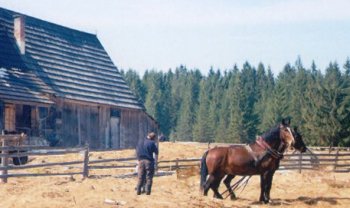 |
Flat but pleasantly green scenery along the way. We went through a string of colourless villages. In the fields, peasants were tilling the earth manually with horses and rudimentary tools. I continued to notice a great deal of graffiti everywhere; some of them disturbing like the ones featuring stars of David accompanied by incomprehensible slogans. Antisemitic? It would be amazing when you realize that three millions Polish Jews perished just a few decades ago and that only a handful, less than 10,000 still live in this country. |
| I took to Czestochowa right away. This is a no frill, no-nonsense city devoid of foreign tourists. Plenty of small shops and reassurringly narrow streets. From the bus terminal, I walked to the pilgrims' guest house located behind the Jasna Gora Monastery, the highest landmark of the town. Perched on a promontary, the white stone building looks quite imposing. Constructed in the 14th century, its somewhat heavy architecture has a certain dignified beauty. | 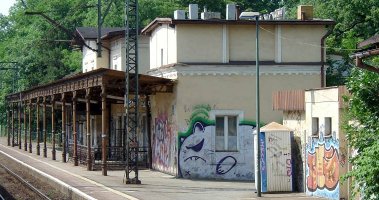 |
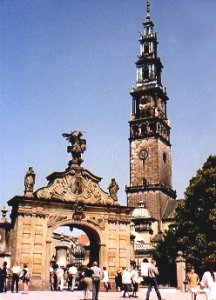 |
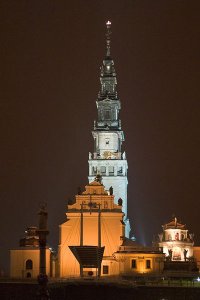 |
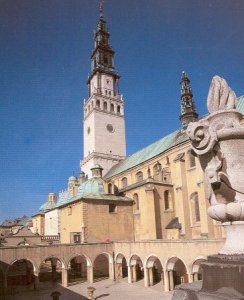 |

| Without a map (my guide book did not provide one!), I started to trek uphill. I crossed the well kept gardens of the monastery adorned with a statue of Jean Paul II and biblical scenes, passed one of the old gates and found myself in one of the coutyards. It was thick with people who had come to pray in front of the Black Madona. I had to elbow my way through the subdued crowd. My pack on wheels was making quite an embarrassing rattle on the cobbled street. People's stares made me feel very conspicuous. I certainly seemed an oddity. I obviously did not belong with my cap and jacket, my hiking boots, my baggage, my |
| camera bag, my frizzy hair and my dark
looks. Deceptively detached, I kept looking around me as if I was wondering
who was making such a noise! Not me!
With a sigh of relief, I exited though another gate and found myself in
front of Dom Pielgrzyma Hostel. A massive structure with hostel, restaurant
and other facilities. At the reception a smiling bespectacled nun attended
me. I inquired:
"Czesc, czy sq wolne pokoje?" (Try to pronounce that!)
|
|
The Madonnas must have listened to my plea. The nun came back, triumphant.
"I have one room left, a single with a private bathroom. It will cost 70
zlotys," she added almost apologetically.
70 zlotys! That was 23 dollars US, a little over my daily budget for sleeping but reasonable for an emergency situation. "I'll take it!" In fact it was quite a room. A pale yellow monastic cell with a crucifix on the wall along with a portrait of the Black Madonna. The narrow bed was very hard like a slab of marble but the piping hot water of the shower largely compensated. And I enjoyed a complete silence, so deep that I could almost hear it. |
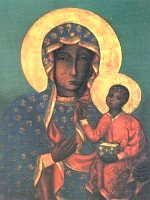 |
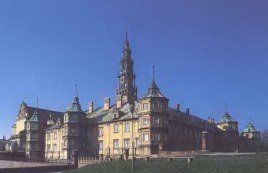 |
A little later I took a stroll to the Monastery, home of the famous Black Madonna. The story is fascinating. Upon the fundation of the Monastery at the end of the 14th century, the monks received the Black Madonna. A few decades later, thieves stole the precious painted panel and viciously slashed the face of the Madonna. According to the story, the lacerated face of the Madonna then started to shed tears of blood. The robbers scared by what they saw fled abandoning their booty. When the monks recovered the painting, they decided to clean it when suddenly a spring came out of the ground. Everybody shouted, "miracle". |
|
A church was constructed on the site to mark the incredible event.
All around the premises I saw paintings of the Black Madonna. I realized that I had come across the original when I entered a small chapel crammed with praying Poles, kneeling with their heads down in a profound trance. |  |
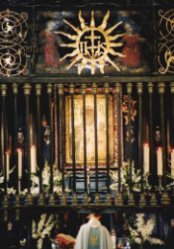 |
There she was, at the center of the altar, magnificent in somber tones. She and the child with a delicately painted gold aura. The portrait looked very much like an icon of the Orthodox Church. On her bronzed face, faint scars were hardly perceptible. The Czestochowa Madonna looked much like a South American Indian. It seemed strange to see these apparently rather xenophobic Polish people praying to and revering such an dark skinned, exotic looking Virgin. She is so dear to the heart of the population that she has been crowned Queen of Poland. | 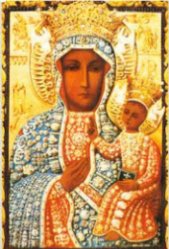 |
|
Why is she black? Some say it is because of the soot residue that discolors the painting. The soot is the result of centuries of votive lights and candles burning in front of the painting. Another tale I heard from my friend Robert: He doesn't know if it is true or not but here goes...At the time of the Crusades many Christian countries sent knights and soldiers to fight in the Holy Land. Among them were the Poles and the Coptic Christians from Ethiopia. Apparently the Poles and the Ethiopians met and came to appreciate one another. As a token of friendship the Ethiopians gave the Poles the Black Madonna. |
| The service was touching. A multitude of people, young and old, peasants with calloussed hands somewhat awkward in their Sunday's best and urban folks, all so absorbed and humble in their adoration of the Black Virgin. Several children wore communion clothes. Girls in white dresses, with a crown of immaculate flowers in their blond hair resembled child like brides. Young boys wore a white robe going down to their ankles making them look like diminutive priests. The organ music and the songs were beautifully moving. A lot of the hymns I had never heard. | 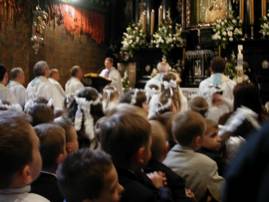 |
| Once the mass was over, I was able to walk around. The chapel devoted to the Madonna was a fitting home for such a revered icon. Splendidly decorated ceilings from which hung exquisitely crafted silver incense burners. On the walls hundreds of crutches from allegedly miraculously cured infirms and a profusion of medallions of the Virgin. The ornate altar was overflowing with fresh bouquets. |
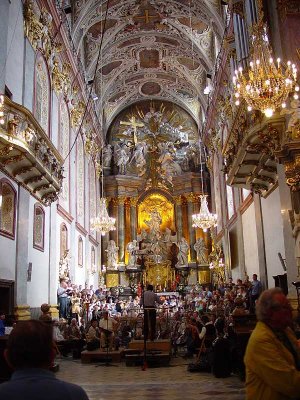 |
 |
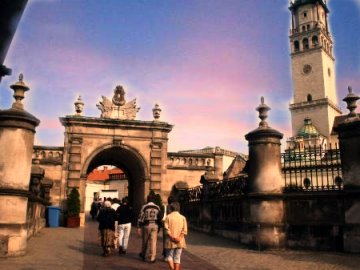 |
I walked for a long time around the Monastery. Still many people about
despite the late hour. It was sunset. All the copper statues of the
park took on a rich gold colour and against the sky on fire the darker
silhouette of the Monastery. I saw the fortifications surrounding the
buildings. Erected in the 17th century, they were so thick that they had
repelled many invasions. Another miracle that was credited to the Black
Madonna!
Talking about crutches and miracles. I have noticed a great deal of people, young and old, in Central Europe hobbling with a cane or crutches. It is a surprisingly common sight. |
| I have been told that work conditions are often unsafe here. When accidents happen at home, in the streets or at work, injured people do not receive adequate medical care and are left with a handicap for the rest of their lives. That is unless they can pay for an expensive operation abroad. Sad but true. This means that if I lived in the Czech Republic or Poland, I would have been unable to have my wonderful hip replacement, would have become irremediably crippled and too incapacitated to enjoy my present travels. I feel blessed. | 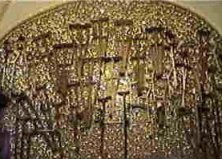 |
| On to Poland... |